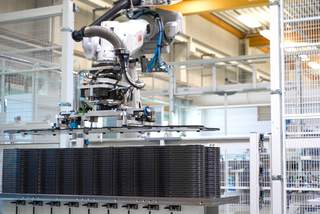
Siemens Energy will manufacture electrolysers on an industrial scale in Berlin in the future. Robots help automate production. © Siemens Energy
Electrolysers: The heart of hydrogen production
Green hydrogen, i.e. hydrogen produced using renewable energies, is seen as the key to replacing fossil fuels with renewable sources. Its uses are diverse: hydrogen can be a storage medium, but also a basic material for other applications, such as synthetic fuels. In addition, hydrogen molecules can also be used as a direct energy carrier in electricity and heat generation, which have been powered by gas up to now. Siemens Energy has been pursuing this path for some time: At its site in Berlin-Moabit, the company manufactures state-of-the-art gas turbines that can already run on up to 50 percent hydrogen. By 2030, they are to run entirely on the green drive.
Last year, the company once again strengthened its position in the field of hydrogen with an investment of billions of euros and is bundling further competencies for the decarbonization of the energy sector in Berlin: In addition to the production of gas turbines, Siemens Energy is also setting up the production of hydrogen electrolysers on an industrial scale in Moabit. New production lines for the heart of hydrogen technology are being built on 2,000 square meters. Production is scheduled to start before the end of the year.
Electrolysers are an indispensable part of hydrogen technology
Hydrogen (H2) exists only in bound form, mainly in water (H2O). To make it usable, it must be released from its chemical bond. This is done by means of electrolysis: the hydrogen and oxygen molecules are separated from each other by the application of electricity. The devices in which electrolysis takes place are called electrolysers. Cost-effective and efficient electrolysers are a prerequisite for meeting the growing demand for hydrogen and its costs in the future. That is why it is crucial that the series production of electrolyzers succeeds.
"With our new production facility, we are helping to make hydrogen competitive more quickly," says Christian Bruch, CEO of Siemens Energy. In Berlin, the company will produce the individual electrolysis cells and combine them into so-called stacks. They will then be assembled into larger modules at the Mülheim site.
Siemens Energy relies on PEM electrolysis (Proton Exchange Membrane), which uses a solid polymer electrolyte instead of a liquid electrolyte. This process is highly efficient and ensures high hydrogen quality. With its new product line, Siemens Energy is optimizing electrolysers for applications up into the higher three-digit megawatt range. This makes it possible to produce several tons of green hydrogen per hour.



